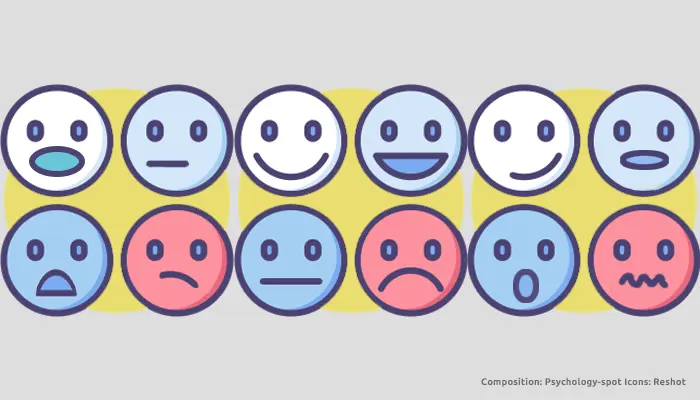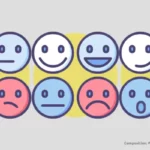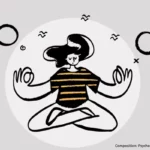
We all experience different emotions and feelings. The human emotional sphere is extremely diverse. However, we are not always able to put a name to what we feel. In fact, some people have very limited emotional self-awareness because, although they experience a wide range of emotions, they are unable to accurately recognize them.
Obviously, not knowing what emotions or feelings we’re experiencing is an impediment to managing them properly . If you only know one or two musical notes, they’ll be the only ones you’ll hear because you won’t pay attention to the rest. If you know them all, your musical universe will expand. The same thing happens in the realm of feelings and emotions: knowing them all will allow you to fine-tune your emotional awareness.
A study conducted at George Mason University, for example, found that people who are able to detect and understand their emotions are less likely to turn to drugs, alcohol, or food as escape routes.
Another study conducted at the University of Kansas went a step further by delving into the impact of emotional self-regulation on the physical level. These researchers found that people with cancer who were able to detect, label, and understand their emotions had lower levels of inflammation, a process that underlies this disease and is considered a poor prognosis.
Neither feelings are so emotional nor thinking is so rational
We often think of emotions and thought as mutually exclusive, antagonistic processes, or even mutually exclusive. However, the truth is that in every emotion there is a grain of reason, and in every thought there is a dose of feeling.
Even if you’re acting on the emotions you’re experiencing at the moment, you’re actually also reacting to a complex mental process that’s been going on in the background: your cognitive interpretation of the event.
The truth is that we don’t react to reality, but rather to the meaning we give it, so our expectations, needs, and even our thoughts also influence it. Therefore, emotions are not merely reactions to a situation, but also an assessment of what is happening to us.
For example, if someone spills a glass of water on you, the most congruent emotional reaction is surprise, since it’s unexpected. However, when you start to think about that person’s intentions and your rational mind kicks in, you’re likely to get angry if you think they did it on purpose. Therefore, anger isn’t an emotional reaction to what happened, but rather a reflection of how it happened.
What is the difference between emotions and feelings?
Knowing the difference between emotions and feelings is not merely an epistemological or linguistic exercise; it will help us better understand our reactions and behaviors, allowing us to regulate our emotional responses to achieve greater well-being.
What are emotions?
They are reactions of affective valence to certain stimuli, which can be external, something we see or experience, or internal, such as a thought or a memory. Emotions unleash a set of hormonal and neurochemical responses that produce a state of activation, propelling us to immediate action. They are usually relatively fleeting experiences that generate a high degree of pleasure or displeasure.
When they give us terrible news, such as the death of a pet or a loved one, for example, it is an emotion that is activated. In these types of situations our reaction is almost automatic and difficult to control, so that we will feel very sad and it is even probable that we will cry.
What are feelings?
Feelings elicit the same physiological and psychological responses as emotions, but they have a conscious evaluation built into them. In other words, they imply awareness and appreciation of the emotion that can be found at its base and the affective experience that we are living. In addition, they tend to be more stable over time.
As the days go by, emotions fade to give way to feelings as a cognitive interpretation of that state occurs. In the case of bad news, for example, the feelings that sadness leaves behind are usually: grief, melancholy, emptiness, restlessness, discouragement or even anger.
Therefore, the main differences between emotions and feelings are:
- Duration. Emotions are transient states that come and go relatively quickly. Feelings, on the other hand, are more stable affective states over time. Joy, for example, is an emotion, while love is a feeling.
- Order of appearance. Feelings are the result of emotions, so the latter usually precede them. Joy, for example, can transform into happiness, and attraction into love.
- Intensity. Emotions tend to be more intense than feelings because their main purpose is to predispose us to action. The complex evaluation processes that often intervene in feelings somewhat diminish their intensity.
- Processing level. Emotions occur unconsciously, generating an almost immediate response, while feelings, taking longer to develop, are processed consciously.
- Degree of regulation. Emotions are affective states that are difficult to control because they generate automatic psychophysiological reactions. We cannot completely contain emotions like fear or joy, for example, since as soon as we experience them, they manifest themselves through microexpressions. Feelings, on the other hand, can be better managed over time by seeking strategies to express them more assertively.
However, emotions and feelings are often difficult to separate in practice, since where there is one feeling there are usually different emotions and vice versa.
Understanding the differences between emotions and feelings helps us, however, avoid feeling guilty about our initial emotional reactions. It also teaches us not to cling to them, so that unpleasant ones can disappear as naturally as they appeared.
How many emotions are there?
In psychology, there is a general consensus that there are six basic types of emotions: fear, anger, disgust, sadness, surprise, and joy. However, recent research has shown that the human face is capable of creating more than 7,000 different expressions that reflect a wide range of emotions.
List of basic and complex emotions and feelings
Basic emotions are simply the foundation upon which we build more complex and subtle feelings and emotions that color our experiences.
*
Positive emotions and feelings
- Joy
- Love
- Affection
- Compassion
- Generosity
- Enjoyment
- Jubilation
- Hope
- Admiration
- Freedom
- Succes
- Justice
- Gratitude
- Acceptance
- Accompaniment
- Kindness
- Appreciation
- Benevolence
- Pride
- Loveliness
- Relief
- Empathy
- Integrity
- Humility
- Attachment
- Approval
- Concentration
- Sufficiency
- Harmony
- Honesty
- Temperance
- Tolerance
- Motivation
- Happiness
- Firmness
- Fortress
- Autonomy
- Honorability
- Solidarity
- Optimism
- Satisfaction
- Security
- Comprehension
- Sympathy
- Affection
- Passion
- Esteem
- Enthusiasm
- Respect
- Peace
- Pleasure
- Commitment
- Fervor
- Charm
- Competition
- Fullness
- Omnipotence
- Euphoria
- Ecstasy
- Illusion
- Support
- Contentment
- Interest
- Trust
- Delight
- Care
- Dignity
- Energy
- Vitality
- Complacency
Negative emotions and feelings
- Sadness
- Melancholy
- Abandonment
- Boredom
- Abuse
- Need
- Absence
- Demotivation
- Scare
- Bitterness
- Anguish
- Aggressivity
- Strain
- Hesitation
- Anxiety
- Disgust
- Revenge
- Courage
- Annoyance
- Shame
- Emptyness
- Boredom
- Hostility
- Humiliation
- Contempt
- Meannees
- Concern
- Stubbornness
- Terror
- Betrayal
- Bothering
- Overwhelmed
- Pity
- Manipulation
- Fear
- Phobia
- Failure
- Fragility
- Frustration
- Fury
- Loneliness
- Unperturbed
- Paralysis
- Grudge
- Rage
- Suspicion
- Shame
- Defenselessness
- Misery
- Dread
- Preoccupation
- Arrogance
- Pessimism
- Incongruence
- Sorrow
- Laziness
- Regret
- Hate
- Rage
- Deception
- Stress
- Bewilderment
- Prosecution
- Vexation
- Envy
- Offended
- Fright
- Sadness
- Stupor
- Impatience
- Distrust
- Impotence
- Confusion
- Disability
- Incompatibility
- Misunderstanding
- Misadventure
- Outrage
- Instability
- Unhappiness
- Inferiority
- Injustice
- Destruction
- Heartbreak
- Dissatisfaction
- Insecurity
- Insufficiency
- Intolerance
- Fury
- Irritation
- Jealousy
- Guilt
- Censorship
- Wrath
- Opposition
- Dependency
- Depression
- Defeat
- Despondency
- Helplessness
- Discouragement
- Restlessness
- Disregard
- Dejection
- Disconsolation
- Misery
- Resentment
- Disenchantment
- Despair
- Reluctance
- Disappointment
- Desolation
- Petrification
- Disorientation
- Contempt
- Famine
- Smear
- Powwerlessness
- Devaluation
- Pain
- Dislike
- Pity
- Laziness
- Dysphoria
- Exasperation
- Regret
- Affront
- Blurry vision
- Affliction
- Disappointment
Ambivalent emotions and feelings
- Nostalgia
- Longing
- Lust
- Unity
- Attraction
- Alarm
- Astonishment
- Courage
- Alteration
- Pride
- Vulnerability
- Valuation
- Temptation
- Patience
- Surprise
- Ambivalence
- Tenderness
- Desire
- Shyness
- Tranquility
- Repentance
- Paranoia
- Disturbance
- Frenzy
- Confusion
- Serenity
- Submission
- Submission
- Soothe
- Rebellion
- Rejection
- Belonging
- Commitment
- Bliss
- Disgust
- Resentment
- Reserve
- Persecution
- Obligation
- Ostentation
- Excitation
- Domination
- Strangeness
- Nonconformity
- Disbelief
- Resignation
- Indifference
- Dauntless
- Intrigue
- Invasion
- Impulsiveness
- Calm
- Consolation
- Restlessness
- Correspondence
- Curiosity
- Closeness
- Worry
- Hesitation
- Disdain
- Rejoicing
- Exaltation
- Condescension
- Equanimity
- Apathy
- Inspiration
- Seriousness
- Trance
- Obstinacy
- Gutter
- Perplexity
It’s worth clarifying that this list of emotions and feelings refers to positive, negative, and ambivalent emotions, but in reality, all emotions and feelings can be negative or positive depending on how we experience and express them . Furthermore, these aren’t even all the emotions that exist, as there are also other emotional states we’ve experienced but that don’t have a literal translation in our language, such as pronoia and awumbuk.
The 3 functions of emotions and feelings
Although Western culture has prioritized reason for centuries and relegated emotions to the background, even turning them into our enemies, the truth is that they are very useful. Even the most unpleasant emotions serve an important function in social adaptation and personal adjustment.
1. Adaptive function
Primary emotions are particularly important because of their hedonic quality. Fear, for example, encourages flight or defensive immobility in the face of danger, while disgust prevents us from eating something that could harm us. Even the expression of fear may be enough to calm an aggressor’s intense reaction.
Surprise, on the other hand, encourages us to pay more attention to what’s happening around us. Therefore, emotions and feelings are a kind of internal compass that allows us to quickly navigate our surroundings and generate the most appropriate response.
2. Social function
Feelings and emotions are powerful social aids. Their expression allows us to predict how others might behave and adjust our behavior to theirs, helping us better adapt to social environments.
Emotions allow us to communicate with our interlocutors through small facial expressions, tone of voice, or body movements. In fact, we are all capable of capturing emotional microexpressions and processing them unconsciously to understand others’ emotional states and predict their intentions.
This ability is what allows us to understand that a person is upset and that perhaps it is not the best time to criticize, or what encourages us to approach someone who is sad to comfort them.
Therefore, emotional reactions not only reveal our emotional state, but are also clues that regulate how others react to us. Even repressing certain emotions can serve a social function, to avoid conflicts or problems in interpersonal relationships.
3. Motivational function
Another of the most important functions of emotions and feelings is their power to energize our behavior. Emotions have a profound relationship with motivation. In fact, emotions can push us to action.
Such is the case, for example, of anger, an emotion that generally triggers aggressive or defensive behavior. Emotions can generate motivated behavior, direct it toward a specific goal, and make us execute it with intensity. Passion is another feeling that can keep us focused on a person or project for a long time.
It’s worth clarifying that this motivational function depends not only on the type of emotion but also on the degree of pleasure or displeasure it generates and the intensity of the emotional reaction. If we’re simply angry, for example, we might be able to control ourselves, but if we’re feeling furious, it will be more difficult to restrain ourselves from giving free rein to that anger.

The bodily expression of emotions and feelings
Emotions and feelings are not merely mental states; they influence our behavior and physiological states. In fact, we often experience emotions directly in our bodies. It’s our bodies that give us the warning signal that something has changed and we need to pay attention.
When we meet someone we love, for example, our heart races or we feel butterflies in our stomach, but when a dog threatens to attack us, our muscles tense and our vision sharpens. On the other hand, the prospect of a job interview or public speaking can make us sweat or even tremble.
Expressing feelings and emotions through the body allows us to more effectively convey our mood, without the need for words. If a person walks with their head down and the corners of their mouth droop, we understand that they feel sad. On the other hand, if we notice that they are blushing and sweating, we realize that they are feeling nervous. Therefore, the body language of emotions and feelings has a powerful communicative function.
However, emotions and feelings are also essential for another reason: they prepare us to face environmental challenges. They allow us to adjust the activation of the cardiovascular, musculoskeletal, neuroendocrine, and autonomic nervous systems to the demands of the environment. This ensures we are able to respond as quickly and adaptively as possible.
Emotions have the power to simultaneously activate some body systems and deactivate others to prevent them from competing for resources, resulting in more effective responses. For example, when we are afraid, the brain issues the order to temporarily shut down unnecessary digestive processes. This is why we often have a dry mouth, as saliva production is reduced. Instead, blood flows more quickly to the lower limbs to help us get to safety, while the lungs expand to allow us to breathe at maximum capacity in case we need to flee.
At the same time, certain emotions, especially those linked to danger, cause a change in brain function. Anxiety, fear, or distress can “disconnect” the frontal cortical areas of the brain that help us think and make rational decisions, prioritizing the more primitive processing system that produces faster responses.
This “emotional hijacking” allows us to react in the blink of an eye, without thinking too much, letting ourselves be guided by what we call “instinct.” Of course, it’s not a very precise system, but it’s effective in risky situations, so it can save our lives.
Along these lines, neuroscientists at Aalto University have even developed a body map based on the subjective sensations we typically experience linked to some of our basic feelings and emotions.

This also means that certain emotional states maintained over time can eventually cause physiological changes that trigger or worsen pathological processes. Psychosomatic illnesses, for example, are often linked to long periods of stress, emotional tension, anxiety, resentment, frustration, or even guilt.
Sources:
Nummenmaa, L. et. Al. (2013) Body maps of emotions. PNAS ; 111(2): 646-651.
Kashdan, T.B. et. Al. (2010) Emotion Differentiation as Resilience Against Excessive Alcohol Use An Ecological Momentary Assessment in Underage Social Drinkers. Psychological Science ; 21(9): 1341-1347.
Stanton, Annette L. et. Al. (2000) Emotionally expressive coping predicts psychological and physical adjustment to breast cancer. Journal of Consulting and Clinical Psychology ; 68(5): 875-882.



